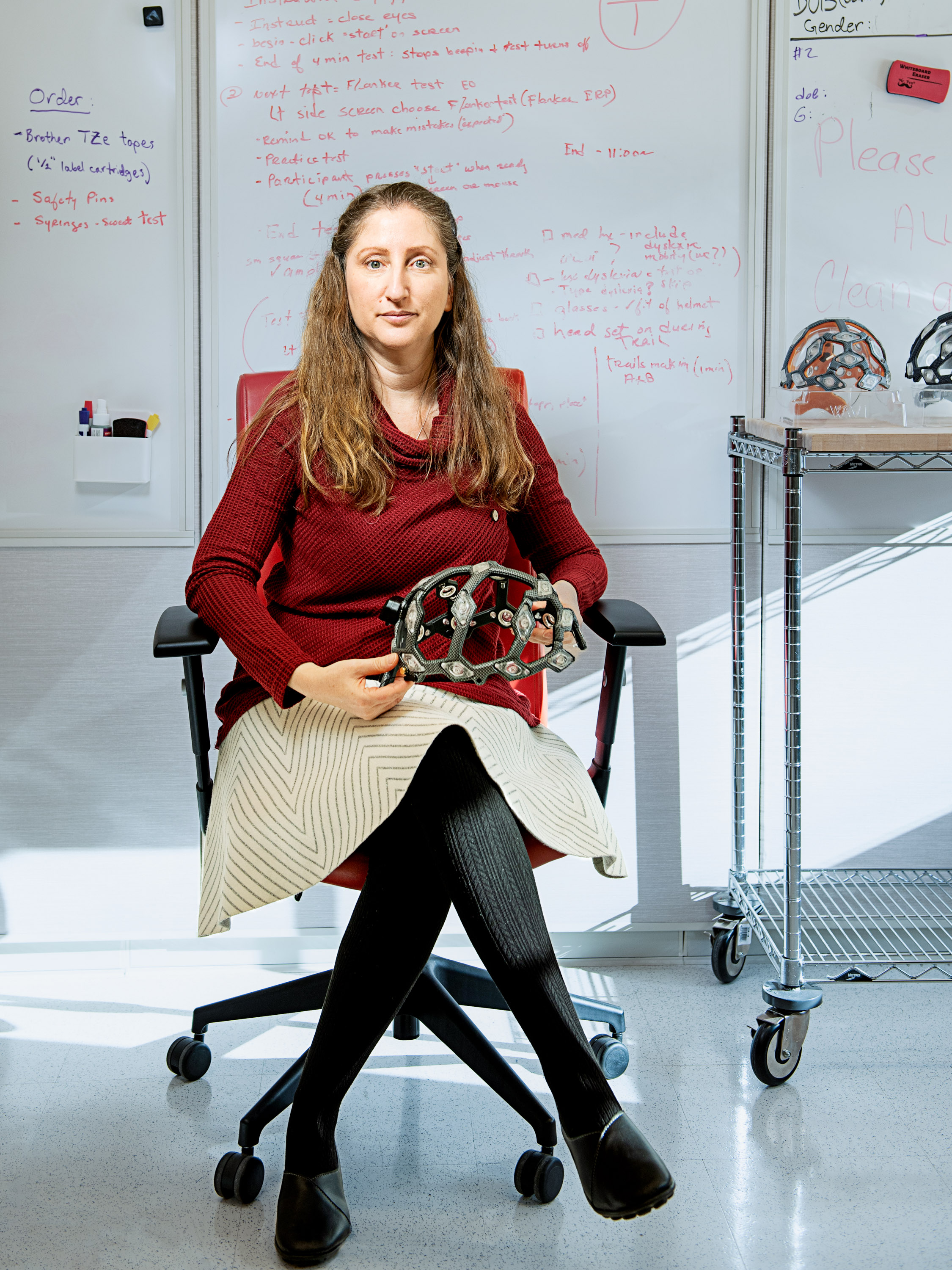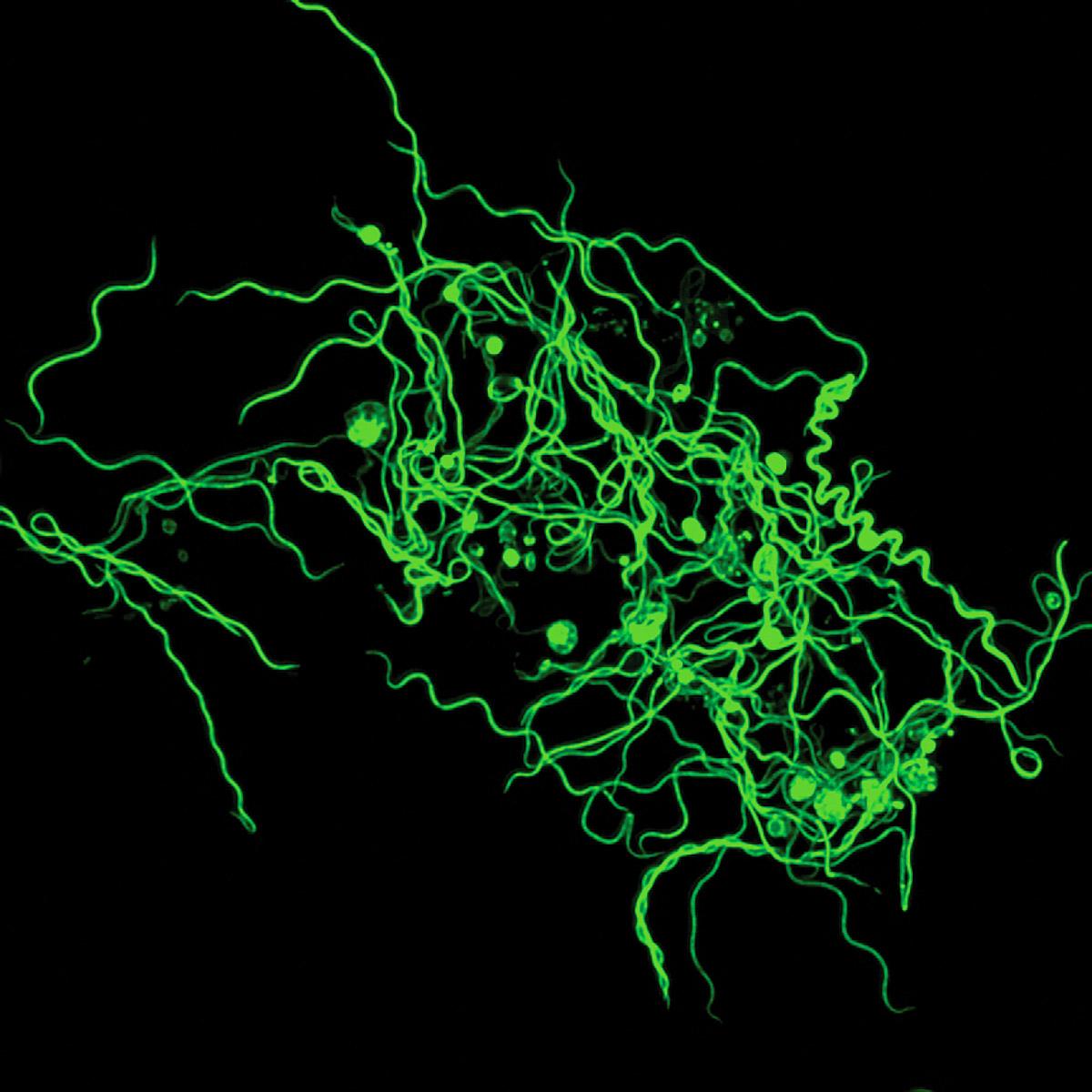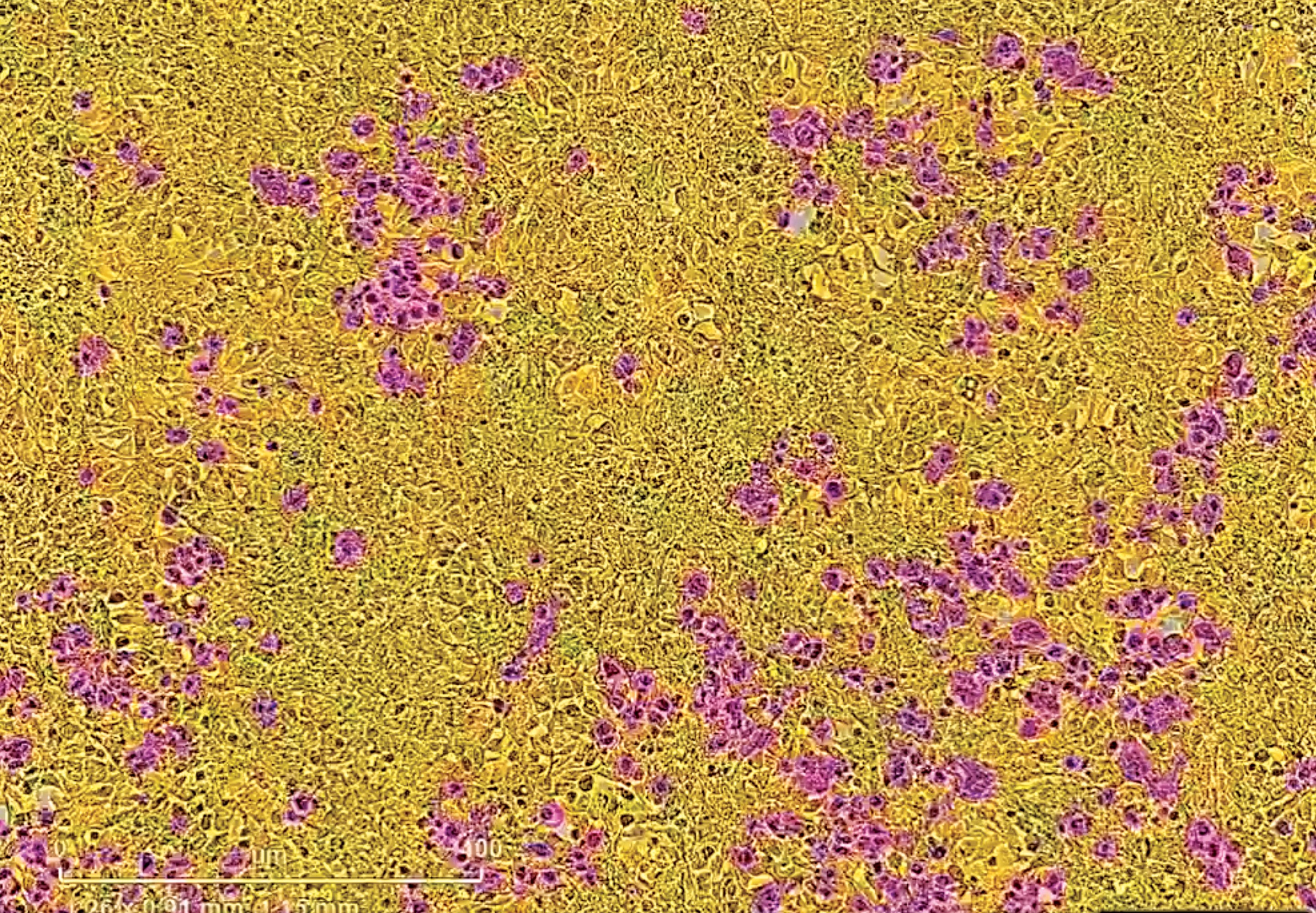Tackling long-haul diseases
Long-haul covid and chronic Lyme disease are surprisingly similar. MIT immunoengineer Mikki Tal is on the case.

MIT immunoengineer Michal “Mikki” Tal remembers the exact moment she had an insight that would change the trajectory of her research, getting her hooked on studying a long-neglected disease that leaves millions of Americans suffering without treatment.
It was 2017, and she was a Stanford postdoc exploring connections between her immune regulation research and immuno-oncology, which harnesses the body’s immune system to combat cancer. Her work focused on how healthy cells broadcast “Don’t eat me” messages while cells that are cancerous or infected with a pathogen send self-sacrificing “Eat me” messages. Immune cells, in turn, receive these missives in pocket-like receptors. The receptor that receives the healthy cells’ signal, Tal read as she was poring over the literature that day, is the third most diverse protein in the human population, meaning that it varies a lot from one person to the next. It was a fact that struck her as “very odd.”
Tal, who has been obsessed with infectious disease since losing an uncle to HIV/AIDS and a cousin to meningococcal meningitis, wondered what this striking diversity could reveal about our immune response to infection. According to one hypothesis, the wide array of these receptors is the result of an evolutionary arms race between disease-causing microbes and the immune system. Think of the receptor as a lock, and the “Nothing to see here” message as a key. Pathogens might evolve to produce their own chemical mimics of this key, effectively hiding from the immune system in plain sight. In response, the human population has developed a wide range of locks to frustrate any given impostor key.
Wanting to test this hypothesis, Tal found herself walking the halls of Stanford, asking colleagues, “Who’s got a cool bug?” Someone gave her Borrelia burgdorferi, the bacterium that causes Lyme disease. Previous research from Tal’s collaborator Jenifer Coburn, a microbiologist now at the Medical College of Wisconsin, had established that Lyme bacteria sport a special protein crucial for establishing a lasting infection. Knock this protein out, and the immune system swiftly overwhelms the bugs. The big question, however, was what made this protein so essential. So Tal used what’s known as a high-affinity probe as bait—and caught the Borrelia’s mimic of our “Don’t eat me” signal binding to it. In other words, she confirmed that the bacteria’s sneakyprotein was, as predicted, a close match for a healthy cell’s signal.
Sex differences in Lyme infection
Until then, Tal says, she had never given Lyme disease much thought. But the more she learned, the more disturbed she grew. Even after timely antibiotic treatment, roughly 10% of all Lyme patients go on to develop chronic symptoms that can include crushing pain, debilitating fatigue, and cognitive changes that make basic tasks a struggle.

Perhaps even more alarming than the disease has been the medical community’s response to it. “I realized that there’s this public health debacle around Lyme, and it’s, for lack of a better word, obscene,” Tal says. Chronic Lyme patients skew female, and for decades, clinicians have dismissed their symptoms as signs of mental illness. The medical establishment has “done nothing but call them crazy,” Tal says, “instead of admitting that they just don’t understand what’s going on.”
Today, there is no objective way to diagnose chronic Lyme, and no medically accepted therapy. For some patients, lengthy treatments with high doses of antibiotics can ease symptoms, but these come with their own serious risks. (They can, for example, damage the microbiome, leading to significant negative effects on health.) And because the antibiotic used currently only prevents bacteria from replicating, Tal notes, it’s up to the immune system to actually kill off the invaders. If immune cells can’t tell friend from foe, the utility of antibiotics may be limited.
Chronic Lyme patients skew female, and for decades, the medical establishment has “done nothing but call them crazy,” Tal says, “instead of admitting that they just don’t understand what’s going on.”
For Tal, these revelations were electrifying. She dove into the immunology of Lyme disease, focusing in particular on sex differences. In one mouse experiment, she discovered that Lyme bacteria “completely disfigured” the uterus. Yet after delving through decades of Lyme research, she could find only one other study that even documented uterine infection.
This shortfall mirrors larger problems in medical research. “We’ve let men dictate the direction of research funding for so long,” Tal says. Traditionally, studies focused on male subjects, and a 1977 FDA policy barred women from participating in most clinical trials in the US in the wake of birth defects caused by thalidomide. It wasn’t until 1993 that federal law required studies to include women and minorities. This, coupled with other sex- and gender-based medical biases, means that many female-dominated diseases remain under-researched. “So much of this research is being done on males, male mice—male, male, male,” Tal says. “And I’m like, no.”
Tal suspects that the sex disparities seen in chronic Lyme and other pathogen-triggered chronic diseases might come down to the fact that men mount a more robust response to acute infection. This no-holds-barred approach is risky—“Your immune system has the power to kill you,” she notes—but it may mean that men, on average, can kill off more viruses or bacteria in the critical first week of infection. After that window closes, the immune system largely settles back down, Tal says. Pathogens that escaped the initial blitz could take up long-term residence in the body, potentially causing persistent symptoms. And women have a higher chance of chronic illness.
The emergence of long covid
In 2020, the pandemic slammed the brakes on most in-person research at Stanford, including Tal’s Lyme studies, and she switched to investigating the salivary immune response to covid. As soon as vaccines were in clinical trials, she shifted to studying the mucosal response to covid vaccines. Meanwhile, reports began emerging that many covid patients never recovered from their acute infections, continuing to face an array of bewildering symptoms ranging from shortness of breath to crushing fatigue and cognitive deficits.
For Tal, the similarities with Lyme disease were uncanny. “Long covid looks exactly, and I mean exactly, like chronic Lyme,” she says. “One is caused by bacteria, and one is caused by a virus. And I started to ask myself this question: Does it matter which road you took to Rome? Or does it only matter that you’re in Rome?”
This is one of the most fundamental questions facing researchers who study infection-mediated chronic illness. One school of thought—backed by increasing evidence in the case of long covid—holds that stubbornly persistent pathogens are driving symptoms in at least a portion of the patient population. According to another hypothesis, the immune system has successfully vanquished the infection but remains stuck in a faulty state. Determining the underlying cause of these conditions will be essential to developing the most effective treatments, whether in the form of immune-assisting drugs such as antibiotics and antivirals or immune-calming drugs such as biologic therapies and steroids.
The MIT MAESTRO study
“Mikki is really a leader about thinking about sex differences in immunology,” says Linda Griffith, director of MIT’s Center for Gynepathology Research (CGR) and the School of Engineering Professor of Teaching Innovation of Biological and Mechanical Engineering. “She is extremely fearless. She’s not going to go along with the crowd because she wants to be liked. And she’s not afraid of proposing something that may be a little out there.”
In 2021, Griffith invited Tal to join CGR as associate scientific director and a principal research scientist in the Department of Biological Engineering to continue her studies of sex-specific responses to infection. When Tal accepted, Griffith says, “it was like a bomb. Like, okay, let’s make this happen.” Tal has since proved to be a compelling ambassador for the center’s work. (In December, for example, her tweet calling attention to the work of CGR went viral when she pointed out that studying the menstrual cycle could have useful implications for wound healing.)

In her first two years at MIT, Tal and her research group put together MIT MAESTRO, a 300-participant study looking for objective biomarkers for chronic Lyme and long covid. (Tal’s team—some of whom have personal experience with these diseases—is orchestrating the work of many labs and companies with different kinds of expertise; MAESTRO is a creative acronym for “mucosal and systemic signatures triggered by responses to infectious organisms.”) Designing and setting up the study was “an incredible feat,” she says. “I could have never done this without my team.”
Treatment of long covid, like chronic Lyme, has been hampered by the fact that standard medical tests rarely show evidence of anything amiss. Through the study—evenly split between healthy controls and patients with acute Lyme, chronic Lyme, suspected Lyme, and long covid—Tal and her research group hope to change this.
As someone who’s had long covid since February 2021, I was eager to take part in the MAESTRO study when I learned about it through an online forum. I became the first study participant to undergo MAESTRO’s unconventional battery of tests, which is how I found myself last March in a dark, quiet room at MIT’s Center for Clinical and Translational Research (CCTR) in Building E-25, zapping aliens with my eyes.
“Long covid looks exactly, and I mean exactly, like chronic Lyme.”
Michal “Mikki” Tal, MIT immunoengineer
As I stared at the computer, waiting for images of aliens to appear on different parts of the screen, the computer also stared back at me, via cameras that followed the tiniest movements of my eyes. While I tracked slow-moving dots, or raced to identify faint gray lines on flashing gray circles, a program watched for abnormalities in the way my eyes moved and focused. After hearing from college-educated patients that they had trouble reading, Tal and her team included these vision-tracking tests to help distinguish between a vision issue and a neurocognitive issue.
Working my way through MAESTRO’s litany of tests felt like a trip to a high-tech carnival midway. There was a gadget to measure grip strength, another to test the electrical properties of skin, and a next-gen EEG cap that looked like a bike helmet. Seated in front of a computer screen, I watched as the seismograph-like lines of my brain activity zoomed all over whenever I blinked or spoke. Tal says they’re using EEG along with the eye-tracking tests and a digital cognitive assessment called BrainCheck to try to characterize and quantify the concept of brain fog.
MAESTRO is also collecting samples of participants’ blood, saliva, sweat, urine, and feces, along with swabs from the throat and vagina. Tal and her research group (a team that currently includes a research scientist, a research specialist, four technical associates, a med school researcher, and several UROP students) are analyzing the samples for genetic material from a vast array of microorganisms, as well as for a range of human and microbial proteins. The tests may show evidence of persistent infections or alterations to the body’s microbiome. With thousands of data points for each subject, the team has enlisted an AI platform to help make sense of the mountain of data they collect. AI will also let them compare their test results with other research involving many thousands of people to help them tease out which features are truly unique in those with long covid and chronic Lyme disease. That’s critical, Tal says, since inflammatory diseases inherently share many features.
A crystal ball for chronic Lyme
By including acute Lyme patients, Tal hopes, MAESTRO will get her closer to another one of her driving goals: predicting who will and will not fully recover after a Lyme-laden tick bite.
In fact, Tal has already identified a compelling lead: the levels of multiple types of antibodies, including IgG and IgE, at the start of infection. She characterizes the different subtypes of IgG as the immune system’s SWAT team—a small, targeted attack that leaves the surrounding neighborhood intact. IgE, in contrast, is like an air strike. It wipes out pathogens but also does serious damage to the body. “IgE is meant to remodel tissue,” Tal says. “Remodeling tissue is expensive and painful, and there’s a lot that can go wrong when you do it that way.”
Today, Lyme tests only look at IgG and another antibody type, IgM, but not IgE. “We’re ignoring the people who have the air-strike reaction,” Tal says. Tracking the levels of IgE, IgG, and other antibodies may hold the key to predicting which Lyme infections will turn into a chronic illness. In July, the National Institutes of Health awarded Tal $2 million to further test this immunological crystal ball. She and her team expect to publish their findings as early as 2025.
The NIH grant, one of several for chronic-Lyme research, signals a shift in the way the medical establishment views these patients. The explosive appearance of millions of covid long-haulers, many of them doctors and nurses, has upended entrenched beliefs about infection-triggered chronic diseases—namely, that they are psychosomatic or an excuse to get out of work. Tal recalls a recent conference where the keynote speaker, acknowledging the eye-opening fact of long covid, apologized for what he had written in the past about chronic Lyme.
As covid infections continue to surge, and as climate change pushes ticks into new habitats, finding out the causes of these conditions and coming up with cures will become ever more essential. Without treatments, many patients are facing a lifetime of disabling symptoms. Tal hopes to find the funding to expand MAESTRO to include more patients over 65, since both epidemiology data and their complementary research with mice suggest that symptoms worsen with age. And the impact could spread beyond long covid and Lyme patients as well. “If we do nothing, we’re going to crush our health systems,” Tal says, “because they’re not equipped for this level of chronic illness.”
As intimidating as these problems are, Tal remains optimistic. “I’m convinced this is a solvable problem,” she says. “I’ve thrown everything I can at trying to find it. And I really hope that we do.”
Keep Reading
Most Popular
Large language models can do jaw-dropping things. But nobody knows exactly why.
And that's a problem. Figuring it out is one of the biggest scientific puzzles of our time and a crucial step towards controlling more powerful future models.
How scientists traced a mysterious covid case back to six toilets
When wastewater surveillance turns into a hunt for a single infected individual, the ethics get tricky.
The problem with plug-in hybrids? Their drivers.
Plug-in hybrids are often sold as a transition to EVs, but new data from Europe shows we’re still underestimating the emissions they produce.
Stay connected
Get the latest updates from
MIT Technology Review
Discover special offers, top stories, upcoming events, and more.